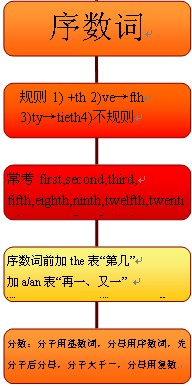本试题 “Radioactive(放射性的) pollution can be said to be the emission(排放) of radioactive substance into air, water or land due to human activities in th...” 主要考查您对序数词
等考点的理解。关于这些考点您可以点击下面的选项卡查看详细档案。
- 序数词
序数词的概念:
表示顺序的数称为序数词。如:first, second, third, fourth。
序数词的构成与用法:
1、序数词的构成:
①一般来说,是由相应的基数词加词尾th构成。
例:four+th→fourth
six+th→sixth
seven+th→seventh
ten+th→tenth
②下面这些基数词在变为序数词时,有特殊的变化。
例:one→first
two→second
three→third
five→fifth
eight→eighth
nine→ninth
twelve→twelfth
③十位整数序数词的构成方法是将基数词的词y变成i,然后再加eth。
例:twenty→twentieth
thirty→thirtieth
forty→fortieth
ninety→ninetieth
④两位或两位以上的基数词变成序数词时,仅将个位数变成序数词。
例:twenty-one→twenty-first
thirty-five→thirty-fifth
a hundred and fifty-three→a hundred and fifty-third
2、序数词的用法:
①序数词在使用时,一般加上定冠词。
例:the first book
the second floor
the third day
the fourth week.
②序数词在多数情况下都用作定语,有的也可以作表语、主语和宾语。
例:The may1st is Labour Day. 五月一日是劳动节。
My room is on the second floor. 我的房间在二楼。
The first is larger than the secon.(主语)第一个比第二个大。
Read the book from the first.(宾语)从开头读这本书。
You'll be the sixth to write.(表语)你将是第六个写的。
③序数词的前面可以加上不定冠词,用来表示“再一”,“又一”的意思。
例:You may have a third try. 你可以第三次尝试。
序数词知识体系:

约数的表达方法:
用tens/dozens/scores/hundreds/thousands/millions of 表示“几十、几百、上千、成千上万”等。
如:The boy bought dozens of pencils.
Thousands of people died in the earthquake.
注意: (A):dozen, score, hundred, thousand, million等表示确切数量时,不用复数。
如:five dozen (of) eggs 五打鸡蛋
hree hundred people 三百个人
分数词的构成和用法:
1)分数词构成法:
分数词(FractionalNumerals)由基数词和序数词构成,基数词代表分子,序数词代表分母。除了分子为1的情况下,序数词都要用复数形式:
如:1/4:one-fourth
5/9:five-ninths
2/3:two-thirds
17/5:three and two-fifths
7/12:seven-twelfths
379/8:forty-seven and three-eighths
此外还有下面表示法:
如:1/2:a(one) half
1/4:a(one) quarter
3/4:three-quarters
9/4:two and a quarter
3/2:one and half
31/4:seven and three quarters
与“Radioactive(放射性的) pollution can be said to be the emi...”考查相似的试题有:
- 在下列的空格里填写括号里单词的正确形式(共8小题, 每小题1分共8分)小题1:The whole world seemed ___________ (shock) at th...
- 阅读下面材料,在空白处填入适当的内容(不多于3个单词)或括号内单词的正确形式,并将答案填写在答题卡相应的位置上。Alice: ...
- 文中共有10处语言错误,每处错误仅涉及一个单词的增加、删除或修改。增加:在缺词处加一个漏字符号∧ ,并在其下面写出该加的...
- What is your favourite colour? Do you like yellow, orange, red? 小题1: . Do you prefer greys and blues? Then you are ...
- 请将标有A~F的备选项插入文章中标号为1~5的合适位置,使其意义完整,结构连贯;期中有一个备选项是多余的。(此题请答在答题...
- After spending a wonderful weekend, Jim would have to return to his ________ duties on Monday.A.commonB.normalC.re...
- In that big fire all their houses were______, so they had to build new ones.A.hurtB.harmedC.injuredD.destroyed
- Visiting a city you have never been before can be a fun. Finding out informations about the citybefore you go can mak...
- He doesn’t lack ______ to learn. You don’t have to tell or force him to do this or that.A.attemptB.motivationC.con...
- — How can I help you?— 小题1: — Would you like to send it surface or airmail?— 小题2: — If you send the parcel with s...